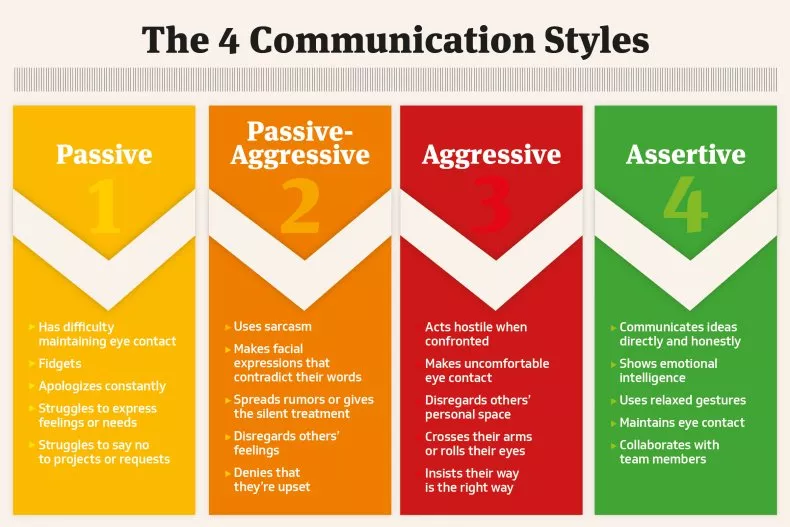Professional communication can be tricky at times. When you send an email or a message, the person on the other end might not understand what you mean. Even if you spend time crafting your message, it can still be misinterpreted. This is especially true in digital communication, where tone and context can easily be lost.
This is important whether you’re working remotely or in person. In emails or chats, you need to be particularly careful with your words and punctuation to avoid confusion. Clear communication becomes even more critical in a remote environment, where face-to-face interactions are limited.
As we continue to work remotely, dealing with difficult team members may become a challenge again. Understanding different communication styles in the workplace can help you work better with your team and avoid misunderstandings. Being aware of diverse communication styles can also improve collaboration, foster better teamwork, and reduce potential conflicts. Let’s explore everything you need to know about it.
Why is it important to pay attention to communication styles?
Understanding communication styles is crucial because it helps prevent misunderstandings at work. When we recognize and adapt to different communication preferences, we reduce the risk of conflict and foster stronger connections between colleagues.
When you know how each person prefers to communicate and master your style, you can deliver important messages more effectively. Tailoring your communication to fit others’ preferences makes your interactions more productive and collaborative. This awareness also improves teamwork, as people feel understood and valued.
Different communication styles can also evoke specific emotions in people who receive the messages. For example, some individuals might feel motivated and empowered when they are communicated with directly, while others may need a more nurturing approach to feel comfortable. Understanding these emotional triggers can guide you in using the right tone and approach for each situation.
Some styles may make them feel empowered, while others could lead to frustration, trust, guilt, or other feelings. For instance, a blunt communication style can be perceived as overly harsh, while an overly indirect approach may cause confusion. Recognizing how each style influences others’ emotional responses helps in adjusting messages to avoid negative outcomes.
To create a positive work environment, it’s essential to embrace work styles that support and encourage employees, avoiding unnecessary negativity. This doesn’t just apply to communication but also to teamwork and collaboration. When employees feel respected and their preferred communication style is acknowledged, it can significantly improve engagement, morale, and overall productivity.
The four styles of communication

In the world of interpersonal communication, different communication styles play a crucial role in shaping interactions and influencing responses. Each style has its own distinct traits, approaches, and methods, which impact how messages are conveyed and understood. Effective communication, whether in personal or professional settings, relies on understanding these styles to improve relationships and promote positive engagement.
These communication styles can significantly impact how people interact with and respond to information. Let’s summarize each one of them. By identifying these styles, individuals can improve their communication effectiveness and reduce misunderstandings. Let’s explore each style in detail.
1. Assertive communication
Assertive communication is a balanced and respectful way of expressing your needs, opinions, and feelings while also considering others’ rights and feelings.
It involves clear and direct communication without being rude or aggressive.
Assertive communicators are often seen as confident and capable in both professional and personal settings, helping to establish clear boundaries and mutual respect.
Example: “I appreciate your input, but I have a different viewpoint. Let’s find a solution that works for both of us.”
2. Aggressive communication
Aggressive communication occurs when individuals forcefully express their opinions and desires, regardless of how it may affect others. This style is often confrontational, intimidating and dismissive of others’ feelings. It can lead to conflict and resentment as it tends to disregard the needs and concerns of those involved in the conversation.
Aggressive communicators often seek to dominate or belittle others, undermining productive dialogue.
Example: “You’re always messing up! Can’t you do anything right? Stop wasting everyone’s time!”
3. Passive-aggressive communication
Passive-aggressive communication combines elements of both passive and aggressive behaviour. People may appear cooperative on the surface, but express their frustration in indirect ways, such as sarcasm, subtle insults or backhanded compliments. This style can be difficult to identify as it often masks true feelings behind a facade of politeness.
While passive-aggressive communicators may avoid direct confrontation, their actions and words can still create tension and confusion.
Example: “Oh, great job finishing the project on time. I wish I had that much free time to do things perfectly.”
4. Passive communication (the star of today’s discussion)
Passive communication involves avoiding conflict and suppressing personal needs or feelings. Individuals who use this style often find it difficult to assert themselves and typically defer to the preferences of others rather than expressing their own desires. This style of communication can lead to a lack of clarity as people hold back important thoughts, which can lead to frustration and a sense of invisibility.
In passive communication, individuals may struggle to speak up for themselves or feel overlooked in group settings.
Example: “Sure, we can do it your way. It’s not a problem.”
While these are the four different commonly known communication styles, we’ll focus on the world of passive communication only.
Understanding passive communication in the workplace is essential, as it can lead to misinterpretations and potential challenges in team dynamics. By exploring this style in detail, we aim to help you identify and navigate passive communication, ultimately fostering a more effective and positive work environment.
Let’s dive into the nuances of passive communication and its implications in the workplace.
What is passive communication?
Passive communication is a way of communication where someone finds it difficult to express their thoughts, feelings, or needs openly.
People who use passive communication might do this because they want to avoid arguments, keep things peaceful, or are afraid of negative reactions if they speak up assertively. In many cases, passive communicators may also lack the confidence to advocate for themselves, further contributing to their reluctance to speak up.
So, how do passive communicators communicate? Instead of expressing their true opinions directly, they tend to hide emotions or defer to others. This often means going along with requests even when they disagree, downplaying their needs, or staying silent in situations where they should speak up. As a result, passive communicators may experience frustration, stress, or resentment that remains unspoken.
When using this communication style, individuals might:
- Avoid eye contact or speak in a soft tone.
- Use apologetic language or hesitant speech.
- Agree to tasks without enthusiasm.
- Downplay their achievements or minimize their own needs.
Typically, passive communicators avoid confrontation and often struggle to set healthy boundaries. This difficulty in enforcing boundaries can leave them vulnerable to manipulation or exploitation, as others may take advantage of their reluctance to speak up.
In short, passive communication is marked by silence, indirectness, or compliance, which often prevents a person’s true needs and feelings from being recognized.
Examples of passive communication
In the workplace, oral communication plays a vital role in fostering collaboration, resolving conflicts, and building strong relationships among team members.
However, not everyone communicates assertively, and some individuals tend to adopt passive communication styles.
Let’s explore several examples of passive communication styles commonly observed in the workplace. Understanding these examples will shed light on the impact of passive communication and how it can affect individuals and teams in professional settings.
- Sarah is asked to work overtime, even though she had planned to attend a family event. Instead of expressing her feelings, she reluctantly agrees to stay at work, suppressing her disappointment.
- Mark disagrees with a colleague’s idea during a team meeting but remains silent and goes along with it to avoid conflict, even though he thinks the project may not succeed.
- Laura feels overwhelmed with her workload but doesn’t speak up about it to her supervisor, as she fears they might view her as incapable of handling the responsibilities.
- During a brainstorming session, Alex has a brilliant idea but hesitates to share it with the group because he worries others might not like it or think it’s silly.
- When Jane’s coworker takes credit for her contribution to a project, she doesn’t address the issue directly and instead chooses to let it go to avoid causing tension in the team.
These examples illustrate how passive communication can lead to unexpressed feelings and unmet needs, often resulting in missed opportunities, unaddressed conflicts, and a lack of personal growth in the workplace.
6 signs to spot passive communication
Effective communication is a fundamental pillar for creating a thriving and productive work environment.
However, recognizing passive communication can be challenging, as it often involves subtle behaviors that go unnoticed.
Developing the ability to spot signs of passive communication is crucial to addressing potential issues and promoting more effective communication within your team.
Here are six key indicators to help you identify a passive communicator, accompanied by real-life examples:
- Avoiding eye contact: Passive communicators are easily spotted by non-verbal cues, they tend to avoid direct eye contact during conversations or meetings. This behavior stems from discomfort in expressing their thoughts or opinions, leading them to avoid confrontation by looking away.
For example, during a team meeting, a team member introduces a novel idea, but a passive communicator avoids making eye contact with them and remains silent, despite having valuable insights to contribute.
- Using apologetic language: Passive communicators often employ excessively apologetic language when expressing their ideas or needs. They may start their statements with phrases like “I’m sorry to bother you” or “I don’t want to be a bother, but…”
- Reluctance to express disagreements: Passive communicators typically shy away from expressing disagreements or raising concerns, even when they hold valid viewpoints. They may fear conflict or worry about negative consequences.
Let’s suppose, in a team brainstorming session, a passive communicator disagrees with a proposed strategy but would rather decide not to voice their concerns to avoid disrupting the harmony.
- Failure to set boundaries: Passive communicators may struggle to set clear boundaries and assert their limits. They might feel obliged to take on additional tasks or agree to unreasonable requests without expressing their preferences.
An example of this could be when assigned a new project with a tight deadline, a passive communicator would usually agree without considering their existing workload, eventually leading to stress and burnout.
- Difficulty initiating conversation: Passive communicators may exhibit hesitancy in initiating conversations, especially when it involves expressing their needs or seeking assistance. They may wait for others to take the lead instead of being proactive.
For instance, if a passive communicator requires guidance on a project but would rather wait for their manager to approach them instead of proactively seeking help.
- Reliance on non-verbal cues: Passive communicators often rely on non-verbal cues, such as sighs, nods, or gestures, to convey their feelings or opinions instead of expressing themselves verbally.
An everyday life example can be taken from daily or weekly team meetings. During these, a passive communicator would usually remain silent but expresses their disapproval through eye-rolling or head-shaking when a controversial topic is discussed.
Impact of passive communication in the workplace
Passive communication can have significant repercussions in the workplace, affecting various aspects of organizational dynamics and employee well-being.
- Misunderstandings and reduced productivity: When employees choose to communicate passively, the intended message may not be effectively conveyed, leading to misunderstandings.
This lack of clarity can result in errors, delays, and ultimately reduced productivity within the team or organization.
- Undermined confidence: Consistent engagement in passive communication can erode an individual’s confidence and self-esteem.
Employees may perceive their opinions and ideas as less valuable, leading to hesitancy in expressing themselves even when they have valuable contributions to make.
- Poor teamwork: In a team setting, passive communication can hinder effective collaboration.
Team members may avoid addressing conflicts or expressing concerns, which can escalate over time and negatively impact group dynamics and overall teamwork.
- Unresolved conflicts: By avoiding open and direct communication, conflicts and issues may go unaddressed.
This can lead to simmering tensions and create a toxic work environment where resentment and frustration build up.
- Lack of innovation: In a workplace dominated by passive communication, new ideas and creative solutions may not be openly shared or explored.
This limitation can hinder the organization’s potential for innovation and growth, as employees may hold back from proposing novel approaches.
- Reduced trust: Trust is a critical foundation in any workplace. Passive communication can erode trust among colleagues and between employees and management.
When people hesitate to communicate openly, it can lead to suspicion and undermine teamwork and cooperation.
Addressing passive communication challenges
To mitigate the negative impact of passive communication and foster a healthy work environment, organizations can adopt several strategies.
- Encourage open dialogue: Create a culture of open dialogue where employees feel safe and encouraged to express their thoughts and concerns without fear of repercussions. Regular feedback sessions and active listening are vital components of such a culture.
- Develop assertiveness training: Offer assertiveness training and workshops to help employees build the confidence to express themselves effectively while maintaining respect for others.
- Set clear expectations: Communicate expectations and responsibilities clearly to ensure that employees understand their roles and are comfortable seeking clarification when needed.
- Promote feedback and recognition: Create a culture of constructive feedback and recognition. Encourage managers to provide regular feedback and acknowledge employees’ contributions, fostering a positive work environment.
- Offer conflict resolution support: Implement conflict resolution programs that empower employees to address and resolve conflicts constructively and proactively.
- Lead by example: Managers and leaders should model assertive and transparent communication, demonstrating that open dialogue is encouraged and valued throughout the organization.
Are you ready to deal with passive communication?
Passive communication can hinder effective collaboration, productivity, and employee satisfaction in the workplace.
This type of communication – where individuals withhold their thoughts or needs – can lead to misunderstandings and disengagement. Identifying passive communication early is key to preventing these problems and maintaining a healthy work environment.
Recognizing the signs of passive communication and understanding its impact is crucial for fostering a positive work culture. Behaviours such as avoiding eye contact, speaking softly or deflecting responsibility are often signs that communication needs attention. Proactively addressing these signs can help avoid bigger challenges and ensure that all team members feel heard and valued.
By promoting assertive communication, setting clear expectations, encouraging regular feedback and offering conflict resolution support, organisations can build a more cohesive and successful team. When employees communicate openly, they feel more confident and empowered, which leads to stronger collaboration and better problem solving.
Embracing proactive communication strategies will benefit both individuals and the organization as a whole. Regular check-ins and feedback loops create a culture of openness, helping to adress concerns before they become issues. This approach leading to increased productivity, innovation, and overall workplace satisfaction.









Add comment